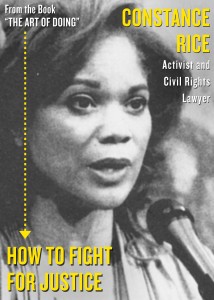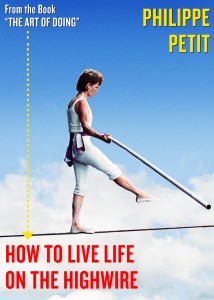Author: Camille Sweeney and Josh Gosfield
Career Advice from Superachievers: Racecar Driver Helio Castroneves
Will Facebook Users Determine the Election?
 A study in the journal Nature reveals the first hard evidence of the Facebook community’s potential political clout.
A study in the journal Nature reveals the first hard evidence of the Facebook community’s potential political clout.A recent study shows that a nonpartisan “Get Out the Vote” Election Day message put out by Facebook during the 2010 Congressional election generated 340,000 additional votes. Facebook sent out this message to all U.S. users 18 and older. Users could click on an “I Voted” button after which their profile pics would appear to friends, and friends of friends indicating they had voted.
While the percentage of these Facebook-influenced votes is small compared to the number of people who voted nationwide—.37%—winning or losing can be determined by tiny slices of the electorate. The 2000 presidential election was decided by less than 0.01% of the vote in Florida.

Researchers determined that it was that Facebook moment of seeing that a friend (or a friend of a friend) had voted that inspired those 340,000 to go vote themselves. It’s what is known as the “social contagion effect” in which a community’s power multiplies, influencing behavior of more and more individuals.
Just as Facebook increased voter participation by encouraging interaction among their users, the superacheivers we interviewed for our book stressed the critical importance of building a community to achieve a goal We heard this over and over. From a teen circumnavigator to a succesful blogger, from a rock band to a war photographer, they actively sought communities with networks as large as possible that could include customers, investors, advertisers, fans, fellow enthusiasts, critics and even competitors.
But back to the election. It’s only a matter of time before campaign operatives figure out how to capitalize on the huge social reach of Facebook’s communities to influence elections. Or alternatively will it be the actual members of the social media communities themselves who determine who’s sitting in the Oval Office?
Simon Doonan: An Artist’s Interpretation
 We are madly in love with the brilliant work of conceptual photographer Henry Hargreaves. So we sent him our chapter (“How to be the Most Fabulous You”) on Simon Doonan—author, style maven, creative ambassador of Barneys New York and high priest of the gliteratti—and implored Hargreaves to “capture” Doonan.
We are madly in love with the brilliant work of conceptual photographer Henry Hargreaves. So we sent him our chapter (“How to be the Most Fabulous You”) on Simon Doonan—author, style maven, creative ambassador of Barneys New York and high priest of the gliteratti—and implored Hargreaves to “capture” Doonan.
Hargreaves, who has created a portrait of Queen Elizabeth out of 1400 pieces of toast, a Damien Hirst dot series out of M&M’s and a portrait of himself out of Jello, decided Doonan was best represented with glitter. GENIUS! And since Doonan’s chapter reminded Hargreaves of “that kind of kid-like thinking where anything’s possible,” he glittered his glasses red as an homage to Dorothy’s ruby slippers in The Wizard of Oz.
 HOW PERFECT?! Dorothy in her magical slippers envisioned an Emerald City much like Doonan who has not only conjured “emerald cities” in his iconoclastic Barneys windows, but encourages us through our clothes, attitude and very way of being to create “emerald cities” of our selves.
HOW PERFECT?! Dorothy in her magical slippers envisioned an Emerald City much like Doonan who has not only conjured “emerald cities” in his iconoclastic Barneys windows, but encourages us through our clothes, attitude and very way of being to create “emerald cities” of our selves.
But in the end, just as Dorothy had to look no further than her ruby slippers for what she needed, Doonan tells us that while fashion arbiters may spark our imagination, it is only when we look inside of ourselves and find our most idiosyncratic individuality that we will discover our most fabulous selves. His fashion credo,
“Evolving your own brand of unique glamour is a process of self-discovery. Reimagine your personal style by uncovering and exaggerating all that is unique about you.”
Hargreaves’s art is based on an iconic photograph of Doonan by Roxanne Lowit.
If you like this post like us on Facebook, follow us on Twitter.
The Art of Doing Artist’s Interpretation project is a collaboration between us and imaginative artists we’ve chosen to depict the superachievers we interviewed for our upcoming book using excerpts from the book.
How a Teacher Learned to Teach by Becoming a Student of her Students

Erin Gruwell was an idealistic young student teacher when she walked into her classroom at Woodrow Wilson High School in Long Beach, California. Gruwell, who we interviewed for a chapter our book, told us that she approached teaching with a lot of assumptions. She believed that with her good intentions and great enthusiasm she could compel her students to embrace the classics. But arriving that first day in her pearls and polka dot dress she was met with an unexpected reality: a class of apathetic and hostile racially-divided remedial students. No one accorded her respect. A paper airplane of her carefully planned syllabus whizzed by her head and as the bell rang she heard a student say, “I give her five days.” Gruwell told us,
“It became painfully obvious that every theory I had learned in my graduate courses paled in comparison to the raw lessons I would learn in my urban classroom.”
Facing failure, Gruwell could have retreated into apathy herself, like so many of her fellow teachers at Wilson High. But instead she told us,
“I became a student of my students…. I had to learn to speak their language instead of expecting them to learn mine.”
Although becoming a student of her students was not an overnight or painless process, the very simple concept changed everything. Eventually, Gruwell not only won over her class by creating a learning environment designed specifically for them, but helped them become the people that she—and they—never imagined possible. And after she coaxed them into writing about their lives, their stories became the bestselling book, The Freedom Writers Diary.
But we all know that letting go of assumptions can be challenging. Without the comfort of our preconceptions we can feel as if we are in a vacuum. It takes humility to admit that we don’t know as much as we think we know. And taking the next step, learning to understand others, can be just as difficult, whether it’s the retailer learning his customers’ needs, the politician studying her constituents or the manager working to know his employees. But the example of Gruwell’s ultimate success at understanding her students is something that we can all strive for.
Erin Gruwell Fact: All 150 of Gruwell’s students graduated from high school, many the first in their families to do so. And along with Gruwell, several of those students formed The Freedom Writers Foundation dedicated to changing the education system one classroom at a time.
How Tennis Legend Martina Navratilova Went from Good to Great
Born with incredible athleticism, by her late teens, Martina Navratilova was one of the top players in the world. But in her early twenties, Navratilova played with uncertain commitment and was prone to puzzling losses.
When we interviewed Navratilova for our book, she told us about a fateful meeting with Nancy Lieberman a one-time pro basketball player that changed the course of her career. At Lieberman’s urgings, Navratilova, who had previously practiced for about an hour a day, took up weight training to achieve peak conditioning, running and basketball to improve reach and footwork and began a daily four hour, on-court practice regimen. Navratilova told us,
“All that training improved my reaction time and speed. I could hit the ball harder. I could run just as hard at the end of a match as I did at the beginning.”
[expand ]
At the time, this form of cross training was unheard of on the pro tennis circuit. Players hadn’t yet conceived of a physical regimen to achieve peak fitness. Because Navratilova was the only player training this way, she had a tremendous physical advantage, which allowed her to dominate the sport.
Once she began to win consistently, Navratilova told us, she “got religion.” She applied the same rigor to improving her diet as well as the mental, strategic and emotional aspects of her game. Navratilova went on to become one of the greatest tennis players ever, winning a record 59 Grand Slam titles in a career that spanned four decades.
What made the difference? Of course, it was the rigorous training that today is understood to be a necessary component of every elite athlete’s success. But just as with an innovative entrepreneur who creates a new business model, Navratilova had the self-awareness to recognize what was lacking in her game. With no precedent or model in her field, Navratilova had the creativity to evolve new ways of achieving her goals and the tenacity to carry through, which put her and kept her at the very top of her game.
We wonder, who is out there today, in tennis or any other sport, who will be tomorrow’s game changer?
Navratilova Records: Most singles title wins—for men or women (167), most singles match wins (1,442), longest match winning streak (74) and only player to win Grand Slam titles in four different decades.
[/expand]
Inside the Mind of Constance Rice: A Civil Rights Activist’s Word Cloud
 Frequency is the currency of a word cloud. The more a word is repeated, the larger it appears in the cloud. (Click to enlarge image above.)
Frequency is the currency of a word cloud. The more a word is repeated, the larger it appears in the cloud. (Click to enlarge image above.)
From this word cloud, based on our interview for our book with Constance Rice (author of Power Concedes Nothing, cousin of Condaleeza), we can see what matters to her most. What you won’t find are the warm and fuzzy words—“compassion,” “nurture” and “help.” Rice is fighter. She’s battled and won $2 billion to improve L.A.’s public transit system, $1 billion to build 147 new schools. She’s negotiated gang truces and effected profound change within the LAPD. And she’s done this at times confronting, at times partnering with, the most powerful forces in Los Angeles—lawyers, politicians, gangs, LAPD and the entrenched bureaucracy. Rice told us rather than to fight for justice one person at a time,
“If you see a need for change you have to ask yourself, ‘Who has the power to get it done?’ Sometimes it’s the voters. When it comes to gangs, it can be gang members and their communities. When it comes to police reform, it’s the police.”
Send Us To SXSW in 2013
Vote HERE to send us to SXSW
South by South West Interactive in Austin, TX is one of the most creative conferences going. Our proposed talk, “The Secrets of Superachievers,” is based on our book, “The Art of Doing: How Superachievers Do What They Do and How They Do It So Well” (Plume, Jan 2013). In the talk, we’ll feature discoveries we made interviewing dozens of extraordinary people including celebrities, businessmen, artists and iconoclastic achievers. We’ll discuss how anyone can learn to incorporate these strategies, principles and tips into his or her own work and personal life. PLEASE VOTE NOW to SEND US to SXSW. All you have to do is go here, register your email, and CAST YOUR VOTE for “The Secrets of Superachievers.” Many thanks in advance, amigos!
How we took the photo.
Inside the Mind of Tony Hsieh: An Innovative CEO’s Word Cloud
If you can’t see image click here
Frequency is the currency of a word cloud. The more a word is repeated, the larger it appears in the cloud. (Scroll over the cloud for full effect.)
From this word cloud, based on our interview with Tony Hsieh, we can see what matters most to him. The words “PROFIT,” “MONEY” and “SHOES” are so small that you’d hardly guess that Hsieh is the CEO of Zappos the largest online shoe store in the world. But the super-sized words, “VALUES,” “CULTURE” and “PERSONAL,” offer us a clue into Hsieh’s thinking. His ultimate goal is not to sell shoes but to create a network of people who share common values and seek a higher purpose. In other words, for Hsieh, Zappos’s billion-dollar shoe business is a means to end. He could just as easily be helming an organic chicken farm or a biotech firm.
Hsieh told us,
“All great companies have a vision that encompasses a higher purpose beyond profits or being number one in the market. And the irony is that the higher purpose enables these companies to generate more profits than their peers.”
Inside the Mind of Philippe Petit: A Highwire Walker’s Word Cloud

Frequency is the currency of a word cloud. The more a word is repeated, the larger it appears in the cloud. And so, from this word cloud, based on our interview with iconoclastic highwire artist Philippe Petit, we have a window into his thinking and what matters most to him. His words describe physicality, adventure and Petit’s poetic balancing act between life and death.
Scroll over the cloud for full effect. (If no cloud appears click here.)





